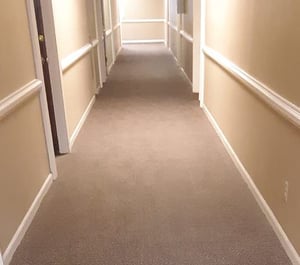Have you ever had a client accuse you of doing something that changed the color of their carpet, rug, or upholstery? Great news if you removed all the soil and revealed the true color of the carpet. But, sometimes a customer is sure that the color after cleaning is not the same as prior to cleaning. There can be many reasons for apparent changes in color. One interesting reason you may not have considered is metamerism.
-1.jpg?width=576&name=My%20Post%20(47)-1.jpg)
Consider another example where fabric seems to change color. You purchase a new suit (or shirt or other article of clothing) in a retail store. When you wear it outside in natural sunlight, the color does not look the same. Why does this happen?
-1-1.jpg?width=300&name=My%20Post%20(45)-1-1.jpg)
Our perception of color is based on three things.
- The light that strikes an object.
- The light that is absorbed by the object (the rest is reflected back to our eyes).
- How our eyes interpret the light reaching them.
White light is a blend of various wavelengths each of which is seen as a different color. You have seen white light split into all the colors of the rainbow using a prism. Sunlight or natural light is a rather even blend of all colors.
The lights in the store may be fluorescent, which produce a light heavy on the blue portion of the spectrum. We also encounter incandescent lights which tend toward the yellow and LED lighting which has its own blend of wavelengths and colors.
As these various types of light strike our new suit, some of the wavelengths or colors are absorbed and others are reflected back. The light reflected back to our eyes depends on the light striking the fabric. It can’t reflect back wavelengths that were not present. So, the color you see will be different depending upon the lighting.
-1.jpg?width=576&name=My%20Post%20(40)-1.jpg)
Different eyes add a third variable. Each of us sees color slightly differently. What one person sees as blue may seem to have a green tint to another.
Pairs of colors that look the same under one type of lighting but look different under other lighting are called metameres. The changes in appearance due to lighting is called metamerism.
Metamerism is more likely to affect colors that are close to neutral including browns and blues common in commercial carpet. Lighter colors like beige or a light mauve are also affected.
How does this affect carpet appearance? Suppose we start cleaning the carpet on a sunny afternoon with natural light pouring in through the windows. We finish later in the day when sunlight is diminished, and the overhead lighting comes from CFL bulbs. The carpet appears a different shade. This is not because we used too much oxidizer or an extra alkalinity. It is simply a change in lighting.
 When looking at the carpet down a hallway, have you noticed that the carpet may appear lighter (or darker) in front of doorways? If the door is open, light may be coming through the door from a different source made up of different wavelengths. Or the ambient light may be striking a colored wall and then reflecting onto the carpet in one area while the light reaching the carpet in another area is first reflected from a door that is painted white. In each case, the appearance of the carpet depends upon the colors available to be reflected back to our eyes.
When looking at the carpet down a hallway, have you noticed that the carpet may appear lighter (or darker) in front of doorways? If the door is open, light may be coming through the door from a different source made up of different wavelengths. Or the ambient light may be striking a colored wall and then reflecting onto the carpet in one area while the light reaching the carpet in another area is first reflected from a door that is painted white. In each case, the appearance of the carpet depends upon the colors available to be reflected back to our eyes.
Some cleaners carry a white light source like a light used when taking photographs or videos. This can be used to show the carpet’s true colors.
